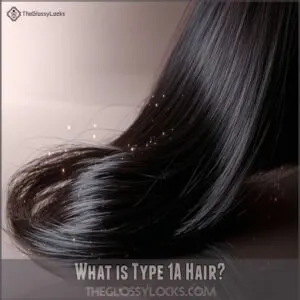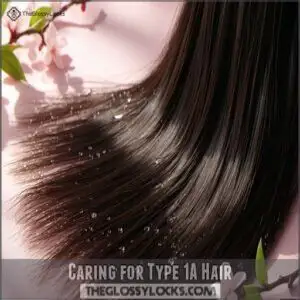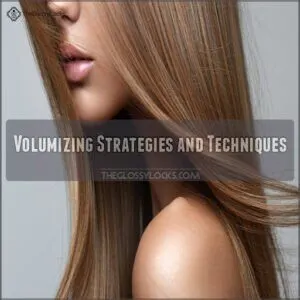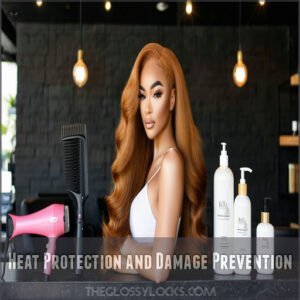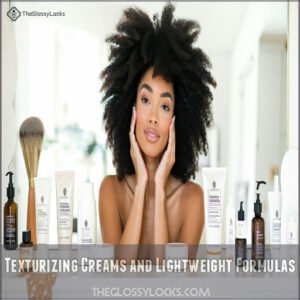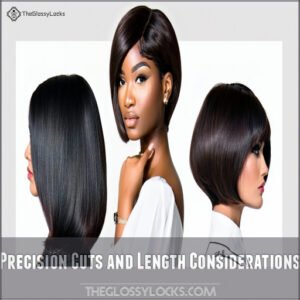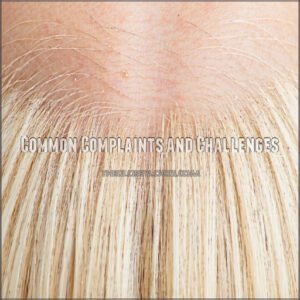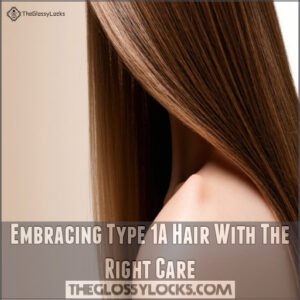This site is supported by our readers. We may earn a commission, at no cost to you, if you purchase through links.
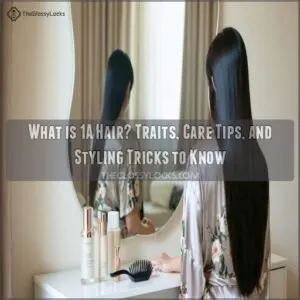 Type 1A hair is the straightest, silkiest hair type out there—think glass-like strands that shine effortlessly.
Type 1A hair is the straightest, silkiest hair type out there—think glass-like strands that shine effortlessly.
It’s super fine and flat, often feeling weightless, but prone to getting oily fast.
This hair type is rare and typically seen in people of Asian descent.
While it’s undeniably smooth and easy to manage, it can lack volume and fall flat, making styling tricky.
Gentle care is key—lightweight products, clarifying shampoos, and avoiding heavy conditioners work wonders.
Embrace its natural sleekness, and with the right tricks, you can add a little oomph without losing its charm.
Want volume? We’ve got you covered!
Table Of Contents
Key Takeaways
- Your 1A hair is pin-straight, fine, shiny, and naturally sleek, but it often lacks volume and gets oily quickly.
- Use clarifying shampoos, lightweight products, and avoid heavy conditioners to manage oiliness and maintain balance.
- Style with root lifters, volumizing sprays, and teasing techniques to add body and prevent flatness.
- Embrace its unique traits like low frizz and natural shine while protecting it with gentle care and minimal heat styling.
What is Type 1A Hair?
Type 1A hair is the straightest and finest hair type, often lying flat and shiny due to natural oils.
It’s rare and typically found in people of Asian descent, making it a unique texture to care for and style.
Characteristics and Rarity
If you’ve wondered, what is 1A hair?, think silky, pin-straight strands with zero waves—like glass.
Known for its fine texture and low follicle density, this rare hair type is fragile but oh-so-smooth.
Genetic factors play a big role, and it’s common in Asian descent.
Handling fine 1A hair? Treat it gently—it’s delicate as it’s unique.
To maintain its health, understanding hair care tips is essential for daily styling and upkeep.
Shine and Oiliness
If you’ve got 1A hair, you know how its natural shine can be both a blessing and a challenge.
The sleek, glossy finish is stunning, but oily hair often comes with it.
Keeping oil balance in check is key—clarifying shampoos can help with grease management without stripping moisture.
To maintain that shine without turning into greasy hair overload, stick to lightweight products designed for fine hair and avoid heavy conditioners.
Common in People of Asian Descent
It’s no secret that Asian hair texture often aligns closely with the 1A hair type.
Thanks to genetic factors, many people of Asian descent have thin, pin-straight strands that shine like glass.
The flatter cuticle structure contributes to the hydration and natural gloss seen in 1A hair women Quora discussions.
While 1A hair on Asian men and women is common, it’s not exclusive to this group—is Asian hair 1A hair always? Definitely not!
Hair diversity proves beauty isn’t one-size-fits-all, no matter what cultural styles you embrace.
Understanding hair cuticle structure is key to managing and styling 1A hair effectively.
Type 1A Hair Defined
It’s like your hair can’t help but be effortlessly sleek.
With 1A hair, there’s no fighting its naturally pin-straight texture—it’s the definition of smooth.
But if you’ve ever tried to curl it, you know the struggle: it’s like convincing water to stay put in your hands.
This hair type is often associated with fine strands that lie flat, giving it a silky, lightweight feel but very little volume.
The even texture means your hair’s natural oil production works overtime.
While it gives an enviable shine, it can also leave your scalp needing extra care.
- Strands that are completely straight, even air-dried.
- A soft, refined feel that’s almost feather-like.
- Frequent greasiness from quick oil distribution.
- Porosity that resists frizz but limits grip for volume.
Caring for Type 1A Hair
Taking care of 1A hair means finding the right balance between managing oiliness and keeping your strands healthy.
With the right products and techniques, you’ll prevent limpness and keep your hair looking polished.
Shampooing Frequency and Techniques
Keeping your 1A hair fresh means smarter shampoo choices and a scalp-focused routine.
Over-washing can strip oils, while under-washing invites grease.
Stick to balanced, gentle cleaning:
- Wash every 2–3 days.
- Use gentle shampoos for fragile strands.
- Focus on the scalp, not tips.
- Rinse completely to avoid product buildup.
- Detangle damp hair carefully.
Moisturizers and Degreasers
Mostrizing and degreasers are your 1A hair’s best defense against oil overload and limp strands.
Lightweight moisturizers keep your scalp happy while avoiding greasy buildup.
Degreasers, like aloe vera or witch hazel, gently cut through oils without stripping moisture, keeping your fine hair balanced and fresh.
Using Aloe Vera Gel products can be particularly beneficial for maintaining healthy hair.
Here’s a cheat sheet for hair success:
| Moisturizer | Degreaser | DIY Boost |
|---|---|---|
| Coconut Milk Spray | Aloe Vera Gel | Green Tea Rinse |
| Rice Water Mist | Witch Hazel Toner | Lemon Water Wash |
| Jojoba Conditioner | Apple Cider Vinegar | Honey Mask |
Sleeping With Dry Hair
When your 1a hair hits the pillow wet, you’re inviting trouble for that fine hair texture.
For further guidance, explore this thorough 1a hair care guide.
Give your strands these nighttime wins:
- Pat gently with a microfiber towel, treating each strand like silk
- Wrap hair in a satin scarf or pop on a night cap
- Smooth on a light hair serum for extra protection
Switch to silk pillowcases – they’re gentler than cotton and help your hair care routine shine through till morning.
Styling Type 1A Hair
You’ll find that styling Type 1A hair is all about working with its fine, straight texture to create lasting volume and movement.
With the right techniques and lightweight products, you can transform your naturally sleek strands into styles that won’t fall flat by midday, which involves understanding how to work with the fine, straight texture to achieve the desired look.
Volumizing Strategies and Techniques
Let’s turn up the volume on your 1a hair with proven strategies.
Start with a volumizing shampoo and conditioner duo as your foundation.
Add root lifters directly at the scalp, then blow-dry upside down for instant lift.
Texture additives like sea salt spray create grip, while strategic teasing at the crown builds height.
For maximum impact, try hair thickeners with lightweight formulas – they’ll boost body without weighing down your strands.
To achieve the best results, consider using products from a volumizing shampoo collection that’s specifically formulated to boost hair volume.
Heat Protection and Damage Prevention
Styling safety starts with using thermal shields to save your 1A hair from heat damage.
Heat guards act as your hair’s armor, keeping burn prevention in check while ensuring damage control.
Stick to cooler temperature settings when blow-drying.
Trust these quick tips:
- Always apply heat protectant spray.
- Stick to low-heat tools.
- Limit heat styling sessions.
- Use protective hair masks.
- Avoid wet-to-dry styling.
Texturizing Creams and Lightweight Formulas
For 1A hair texture, texturizing products and lightweight formulas are absolute game-changers.
A dab of texturizing cream adds subtle definition, tackling flatness without overloading your hair.
You can find a variety of texturizing hair cream products online.
Opt for lightweight formulas like volumizing shampoo to keep your strands airy and full of life.
These styling secrets help fine hair types hold volume while enhancing texture effortlessly—perfect for that extra flair minus the heaviness.
Precision Cuts and Length Considerations
Finding the perfect style for your 1A hair is about balance and creativity.
Consider these options:
- Blunt Ends: A chin-length bob or collarbone cut creates a polished look for sleek strands.
- Layered Styles: Long layers add lift and texture to combat flatness.
- Short Crops: Pixie cuts or 1A haircuts for men embrace minimalistic charm.
Precision cutting transforms your natural hair length into effortless beauty.
Common Complaints and Challenges
It’s no secret that 1A hair comes with its fair share of struggles, from stubborn flatness to nonstop oiliness.
You might also notice annoying flyaways, breakage, or a lack of volume that can leave your hair feeling lifeless.
Dryness and Flatness
Struggling with dry, flat 1A hair?
Boost moisture balance with light hair masks weekly, and embrace the dry shampoo benefits to keep oil in check and roots fluffy.
For fine hair, opt for volumizers and styling sprays that lift without buildup.
These flat hair solutions help create that airy, bouncy look while keeping your delicate strands happy and healthy.
Oiliness and Limpness
Oiliness and limpness can make managing 1A hair feel like a daily battle.
Tame greasy roots and flat hair with simple tricks:
- Control oil by shampooing every other day with lightweight, gentle cleansers.
- Reduce shine with a spritz of dry shampoo.
- Add lift using blow-dry techniques like flipping your head upside down.
- Boost volume with fine-hair-friendly mousses.
Stubborn Flyaways and Breakage
Humidity wrecking your vibe? Flyaways and 1A hair breakage have us all sighing. Skip cotton pillowcases—go satin. Brush gently with a soft-bristle brush. Regular trims? Non-negotiable.
Try these quick fixes:
| Problem | Cause | Solution | Bonus Tip |
|---|---|---|---|
| Split Ends | Over-styling | Trim frequently | Use a leave-in cream |
| Flyaways | Humidity | Light serum | Hydrate often |
| Excess Oil | Daily washing | Dry shampoo in-between | Wash every 3 days |
| Breakage | Rough handling | Satin pillowcases | Comb when nearly dry |
| Frizz | Lack of moisture | Use a hydrating mask Apple Cider Vinegar Rinses to enhance shine. |
Embracing Type 1A Hair With The Right Care
Caring for Type 1A hair doesn’t have to feel overwhelming when you know what works best.
By following a few simple tips and embracing its unique traits, you can keep your hair looking healthy and stylish.
Dos and Don’ts of Hair Care
Flat, limp strands or unwelcome flyaways? You can tame your 1A hair type with the right hair care routine.
Start with gentle combing—always detangle from the ends to avoid hair breakage. Stick to lightweight product selection; heavy options can sabotage volume.
Use shampoos sparingly to avoid over-stripping oils while keeping hair oil control on point. Skip conditioning at the roots, and avoid frequent heat styling—it’s all about protecting those delicate strands.
A quick scalp massage boosts circulation and balances oil production, making daily routines easier for healthier, straight hair care.
Understanding hair care basics is essential for maintaining the health and appearance of 1A hair.
Learning to Love Your Hair Type
Embracing your 1A hair type starts with seeing its beauty beyond stereotypes.
Your shine? It’s a showstopper.
The low-maintenance vibe? Total win.
Celebrate your unique hair journey with effortless simplicity:
- Flaunt silky, frizz-free strands that reflect light effortlessly.
- Rock styles that highlight your natural elegance.
- Redefine beauty standards with hair confidence.
- Simplify routines with essentials for easy 1A hair care.
Frequently Asked Questions (FAQs)
Is type 1A hair easy to care for?
It’s funny how something so sleek can still be tricky—1A hair’s simplicity can fool you.
It’s easy to maintain when you balance regular washing, lightweight products, and avoid overloading with heavy conditioners or oils.
What is type 1A hair?
Type 1A hair is super slim, pin-straight, and shiny, but it can lack volume and get greasy fast.
Think ultra-smooth strands that rarely frizz and need careful care to avoid breakage and flatness.
What does 1A hair look like?
Straight as an arrow" nails it—1A hair is pin-straight, super fine, and shiny.
It’s sleek, flat, and lacks volume, often lying close to the scalp, with strands slipping through your fingers effortlessly.
What makes 1A hair unique?
You’ve got hair so straight it skips the drama—silky, shiny, and resistant to frizz.
The rare Type 1A stands out for its fine texture, natural sleekness, and fast-shining oils, keeping things effortlessly smooth.
What is thick 1A hair?
Thick 1A hair is rare and slightly fuller than typical 1A strands, but it’s still straight, smooth, and shiny.
It handles grease just as easily, often staying sleek but tending to look extra flat, with 1A hair being a key characteristic in this context.
Do you have 1A hair?
You wouldn’t "have" 1A hair unless it’s your natural type—it’s not something you choose.
If your hair’s super straight, silky, and fine, chances are you’re rocking that rare and delicate 1A type.
Is my hair 1A or 1b?
If your hair air-dries completely straight, is fine, shiny, and often looks flat, it’s likely 1A.
If it’s still straight but slightly thicker and holds a tiny bit more volume, it’s 1B.
Is 1A the rarest hair type?
Yes, 1A hair is the rarest type.
Its perfectly straight, fine texture is uncommon, often seen in people of Asian descent.
It’s delicate and shiny but requires thoughtful care to avoid breakage and oiliness.
What is 3a hair?
Your 3A hair has a defined, loose curl pattern.
It’s bouncy and shiny, with S-shaped curls that are bigger than your finger.
It’s prone to frizz but has natural volume and body.
Am I 2A or 2B hair?
2A hair has loose, slight S-shaped waves and is less defined, while 2B is wavier with more definition and minor frizz. Look closely after air drying to identify yours.
Conclusion
Think of your Type 1A hair as a smooth canvas—sleek, shiny, and effortlessly unique.
While it may come with challenges like oiliness or flatness, the right care routine can transform it into a showstopper.
With these tips, your hair won’t just shine—it will thrive. Learning what 1A hair needs is the first step in loving its natural beauty and discovering its full potential.

